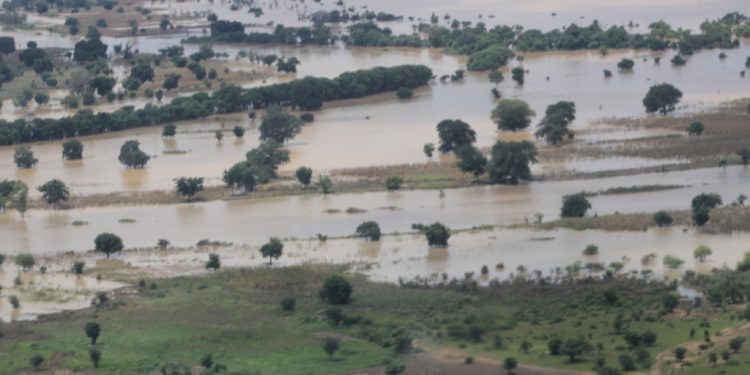The National Disaster Management Organisation (NADMO), in collaboration with SONABEL Energy, managers of the Bagre Dam in Burkina Faso, and Mr. Donatus Atanga Akamugri, the Upper East Regional Minister, has issued a stern warning to residents living along the White Volta to prepare for possible flooding following the opening of the Bagre and Kompienga dams.
The authorities cautioned that communities in flood-prone and low-lying areas must urgently relocate to higher grounds to prevent the loss of lives, destruction of farmlands, and displacement of households.
Districts at high risk
Several districts across four northern regions of Ghana have been listed as potentially vulnerable.
In the Northern Region, the areas identified include Gushegu, Karaga, Nanumba South, Tolon, Kumbugu, Savelugu, Nanton, Yendi, Saboba, Zabzugu, and Tatale/Sanguli.
In the Upper East Region, the risk zones comprise Bawku Municipal, Binduri, Talensi, Garu, and Bawku West.
The North East Region districts likely to be affected include East Mamprusi, West Mamprusi, Mamprugu Moagduri, Chereponi, and Bunkpurugu/Nakpanduri.
In the Savannah Region, NADMO highlighted East Gonja, Bole, North Gonja, Central Gonja, Bole Bamboi, and Sawla Tuna Kalba.
NADMO’s emergency precautions
In a statement, NADMO stressed the urgency of precautionary measures, describing relocation as vital to saving lives and minimising property damage.
“We appeal to the media, opinion leaders, and local authorities to help disseminate this vital information, ensuring that no one is left uninformed,” the statement said.
It further urged communities to remain calm, cooperate with disaster officials, and strictly follow safety directives. NADMO assured that monitoring systems were in place, and emergency response measures were being coordinated with district assemblies, security agencies, and health authorities.
Minister urges farmers to act swiftly
Upper East Regional Minister, Mr. Donatus Atanga Akamugri, called on farmers along the White Volta River basin to take proactive steps to protect their livelihoods.
He advised that farmers with mature crops should harvest them without delay, warning that prolonged flooding could submerge non-resistant crops, leading to severe agricultural losses.
“We pray the spillage will not be too much, but if it is, the impact on farmers will be significant, and it will eventually affect the food supply of the entire nation,” he said in an interview with the Ghana News Agency in Bolgatanga.
Technical details of the spillage
According to the Water Resources Commission, SONABEL, the power-producing company of Burkina Faso, began releasing excess water from the Bagre Dam on Monday, August 25, 2025, at about 10:30 a.m., at a discharge rate of 47.34 cubic metres per second.
The released water is expected to flow downstream into Ghana within 72 hours, threatening communities along the White Volta in the Upper East and North East Regions.
Experts warn that the river may overflow its banks, leading to widespread flooding in districts such as Binduri, Bawku Municipal, Bawku West, Talensi, and Nabdam.
Preparedness and relief efforts
The Regional Disaster Management Taskforce has intensified sensitisation campaigns, urging communities to move to safer locations.
Relief logistics are being mobilised in anticipation of possible displacements.
Mr. Akamugri revealed that NADMO has been requested to provide emergency supplies, including mattresses, buckets, cups, gloves, and Wellington boots, to aid quick response in case of flooding.
He further appealed to traditional leaders and local opinion leaders to support disaster management officials in educating the public on safety protocols and relocation strategies.
Annual threat to northern Ghana
The annual spillage of the Bagre and Kompienga dams is carried out to protect the integrity of the facilities in Burkina Faso.
However, the controlled releases often bring untold hardship to downstream communities in northern Ghana, submerging farmlands, destroying homes, and disrupting livelihoods.
This year, the Bagre Dam spillage again poses a threat to food security, as many farmers along the White Volta basin face the risk of losing crops and livestock to the floodwaters.
Authorities have, therefore, reiterated their commitment to prioritising the protection of lives and properties while appealing to communities to act swiftly and responsibly to minimise the impact.











